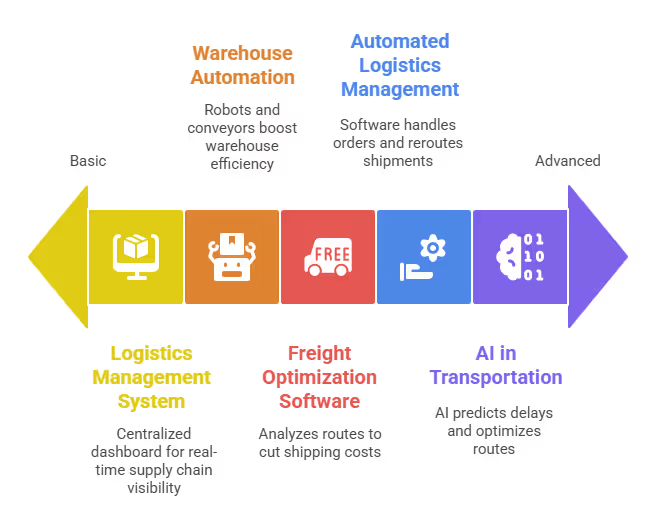Digital Transformation in Logistics and Transportation

Digital Transformation in Logistics and Transportation: A Summary
- Digital transformation in logistics and transportation integrates technologies like IoT, AI, and blockchain to enhance real-time tracking, route optimization, and supply chain visibility, driving efficiency and reducing costs.
- Key benefits include automation of warehouse operations and predictive analytics for demand forecasting, minimizing errors and enabling agile responses to market changes.
- Challenges involve integrating legacy systems, cybersecurity risks, and skill gaps, requiring strong change management and investment in employee training.
- Leading practices from companies like DHL and UPS emphasize data-driven decision-making and cloud-based systems for improved customer satisfaction and sustainability.
- Future trends focus on autonomous vehicles, robotics, and big data analytics to foster innovation, with market growth projected to reach $145.28 Bn by 2025.
Hey there, logistics warrior. Picture yourself in a Chicago warehouse at 7 a.m., coffee in hand, staring at a backlog of orders while your phone buzzes with a client demanding same-day delivery to Miami.
Sound familiar? In the USA, logistics is a $2.5 trillion beast, but inefficiencies like delayed trucks and overstocked shelves are eating 12-15% of your profits, according to a 2024 McKinsey study.

Why Logistics Transformation Feels Like a Superpower
Ever feel like your supply chain is a house of cards, one delay away from collapse? Logistics transformation is like swapping that shaky deck for a steel fortress. It’s about using tech to move goods faster, cheaper, and smarter across the USA’s sprawling highways and ports.
Here’s the difference it makes:
Logistics Management Systems: Your Secret Weapon
Imagine having a dashboard that shows every truck, order, and inventory level in real-time. That’s a logistics management system (LMS), your supply chain’s brain. A Texas retailer used Blue Yonder’s LMS to manage 20,000 SKUs, slashing stockouts by 28%.
Here’s what you get:
- Real-time visibility: Know where your Chicago-to-LA shipment is, down to the mile.
- Error-free orders: Automation cuts mistakes by 35%.
- Smarter forecasting: Predict demand like a pro, no crystal ball needed.
- Scalable: Works for a 10-truck fleet or a national giant.
You’re not just managing, you’re dominating. What’s stopping you?
Warehouse Automation: From Chaos to Clockwork
Ever seen a warehouse worker sprint to find a misplaced box? Warehouse automation turns that chaos into clockwork. Robots, conveyors, and smart shelves boost efficiency by 30%, per a 2024 Deloitte report.
Real example: Target’s Ohio warehouse used robotic arms to process 50% more orders, saving $3 million in labor costs in 2024. Small businesses can start with $5,000 scanners, benefits of warehouse automation aren’t just for the big dogs. Plus, advantages of automated warehouse systems include lower energy use (15% less, per NFI Industries) and happier workers who focus on strategy, not heavy lifting.
Freight Optimization Software: Save Cash on Every Route
Shipping from Seattle to Dallas and feeling the fuel bill sting? Freight optimization software is your money-saver, analyzing routes, loads, and traffic to cut costs. A 2024 Logistics Management study showed 18% savings for optimized fleets.
Here’s the payoff:
- Cheaper routes: Save $600 per truck monthly.
- Fewer empty miles: Cut waste by 12%.
- Real-time tweaks: Dodge a Texas storm or I-95 traffic jam.
- LMS integration: One system, no headaches.
Case study: JB Hunt saved $12 million in 2024 by optimizing 1,500 daily routes with Oracle Transportation Management. Your move: Stop burning cash on inefficient shipping.
Automated Logistics Management: Run It Like a Boss
What if your supply chain ran smoother than a cross-country road trip? Automated logistics management uses software and sensors to handle orders, track shipments, and reroute trucks around a Denver blizzard. Ryder’s platform cut delays by 22% for a US grocery chain in 2024.
Here’s the difference:
Why you’ll love it: Scale your operation without hiring a dozen new people.
AI in Transportation and Logistics: Your Brain Trust
How do you stay ahead when competitors are nipping at your heels? AI in transportation and logistics is like having a genius co-pilot. It predicts delays, optimizes routes, and cuts costs. In 2024, UPS saved $500 million by shaving 130 million miles off routes with AI.
AI logistics intelligence delivers:
- Predictive maintenance: 30% fewer truck breakdowns.
- Route optimization: 12% less fuel, $1,000 per truck monthly.
- Customer transparency: Real-time tracking boosts trust by 20%.
- Demand insights: Know what’ll sell before it trends.
Example: A Kansas City distributor used AI logistics intelligence to dodge port delays, saving $1.5 million. Your edge: Make smarter calls, faster.
Future of AI in Supply Chain: Dream Big, Stress Less
What’s next for logistics? The future of AI in supply chain and future of AI in logistics is wild, think self-driving trucks and warehouses that predict holiday demand in July. By 2030, 28% of US deliveries could be autonomous, per McKinsey.
But will AI replace supply chain management?
Let’s settle that fear:
AI’s your sidekick, not your replacement. Walmart’s Arkansas warehouse used AI to boost efficiency by 40%, but managers still run the show.
Why this matters: Embrace AI to shine, not stress.
AI in Inventory Management: Stock Like a Pro
Ever overstocked a product that flopped? Artificial intelligence in inventory management is your crystal ball. How is AI used in inventory management? It crunches sales data, weather, and social media trends to predict demand with 92% accuracy, per a 2024 SAP study.
Benefits:
- No overstock: Save $200,000 annually on waste.
- Dynamic stock: Adjust levels across 10 US warehouses.
- Real-time updates: Sync with e-commerce platforms.
- Proactive planning: Know what’ll sell before it trends.
Example: A Florida retailer used IBM Watson to cut excess inventory by $700,000 in 2024.
Your win: Stock smarter, profit more.
Transport Management System Website: Your Fleet’s GPS
Managing a fleet without a transport management system website is like driving cross-country without GPS. Platforms like Manhattan Associates let you track trucks, plan routes, and stay DOT-compliant. A small TMS trucking company in Ohio saved 15% on fuel with C.H. Robinson’s TMS.
Features include:
- Live tracking: Know where your 50 trucks are, instantly.
- Automated contracts: Save 10 hours weekly on paperwork.
- Route optimization: Cut fuel costs by $500 per truck monthly.
- Compliance: Avoid fines with built-in DOT rules.
Why you need it: Stop playing phone tag with drivers.
Busting Barriers: Digital Transformation for Every US Business
Worried about costs or tech know-how? I get it, new tech can feel like a leap. But small businesses can start with $5,000 scanners, and cloud-based LMS costs $400/month.
Training’s key: Schneider National upskilled 1,200 workers in 2024, boosting adoption by 50%.
Your plan: Start with one tool, track ROI, and scale up. You’ve got this.
Why Hakuna Matata Is Your Logistics Game-Changer
You’re not just running a supply chain, you’re building a legacy. Hakuna Matata, the USA’s top agency for digital transformation in logistics, has helped 500+ businesses, from Seattle startups to Dallas giants, save millions with AI, automation, and LMS. Our secret?
We get your pain and craft solutions that fit your budget and goals.
Want to start winning? Fill out the form below for a FREE guide on logistics tech and a 1-hour KT session with our experts.
Don’t let competitors steal your edge.
Get Your Free Guide and KT Session Now

